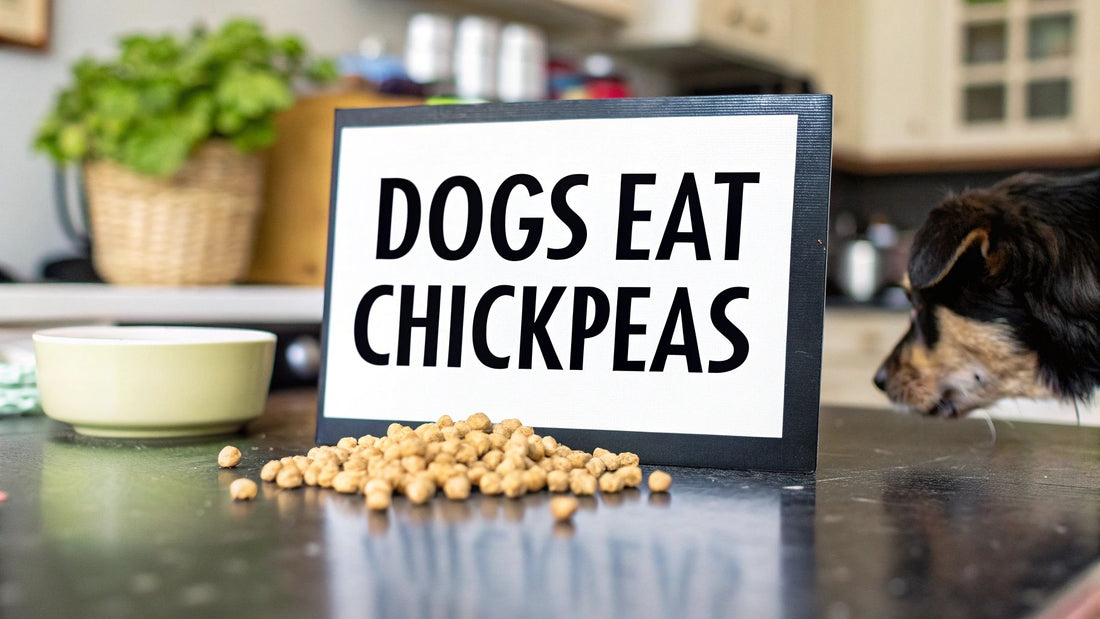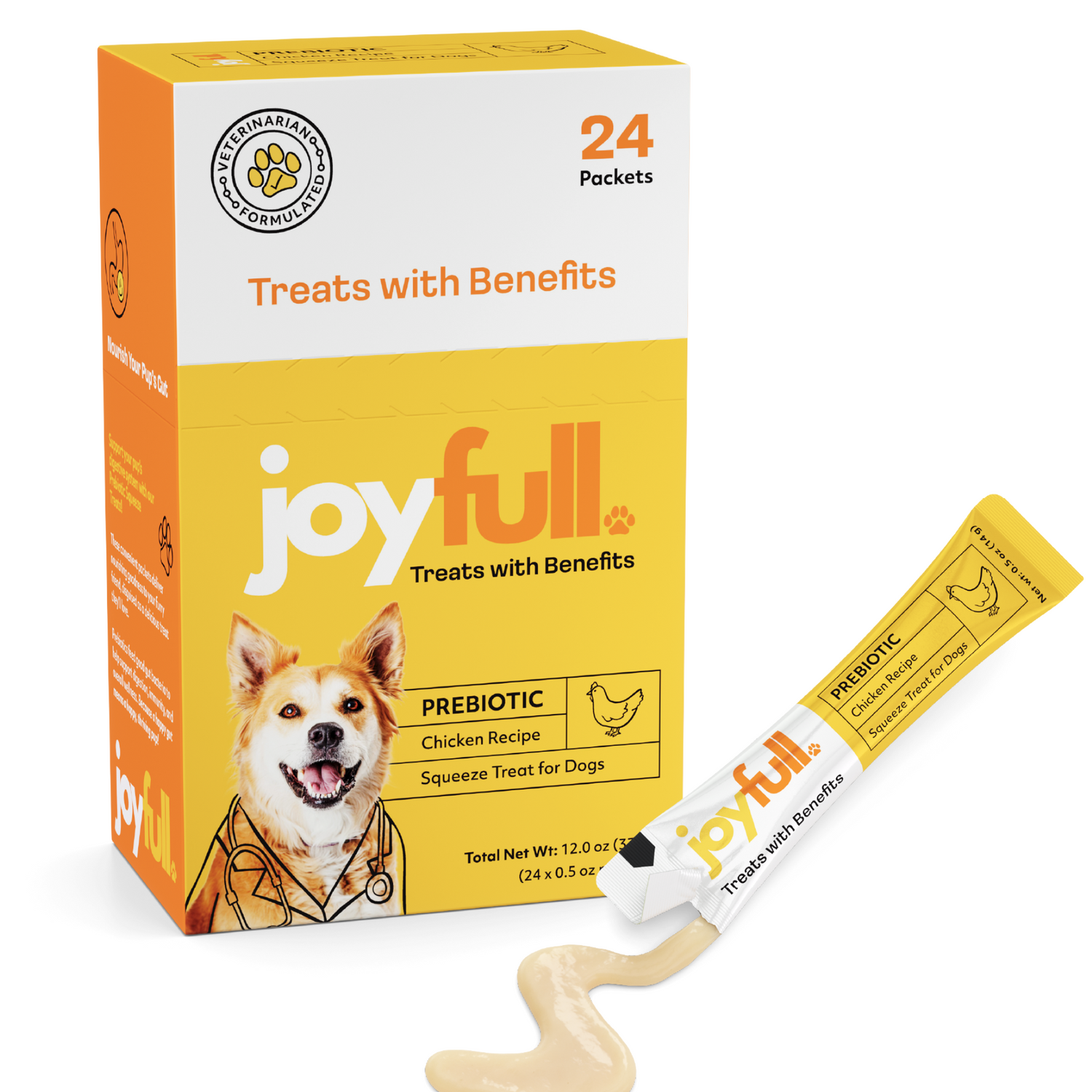
Can Dogs Eat Chickpeas? Safe Tips & Benefits You Should Know
So, you're enjoying some hummus or tossing garbanzo beans into a salad and your dog gives you that look. It's a common scene, and it always leads to the same question: "Can my dog eat chickpeas?" The answer is yes, absolutely! But there's a huge catch—how you prepare them makes all the difference.
Think of it this way: plain, cooked chickpeas are a healthy "green light" for your pup. Almost every other form, though, is a hard "red light."
It might surprise you that this humble legume can be a fantastic, nutritious little snack for your dog. Chickpeas, or garbanzo beans, have been a staple in human diets for centuries, and they've found their way into high-quality dog foods for good reason. They're packed with protein and fiber, making them a healthy bonus.
Just to give you an idea of how popular they are, countries like India, Australia, and Turkey grow them by the truckload. In 2023, India alone produced around 10 million metric tons! Their move into pet nutrition, which you can read more about on hepper.com, is a natural next step given their impressive nutrient profile.
How You Serve Chickpeas Matters
Making the right choice for your dog comes down to knowing what’s safe and what isn’t. Raw chickpeas are a no-go; they’re tough for a dog to digest and will likely lead to an upset stomach. Canned versions are another minefield because they’re usually swimming in a salty brine that’s way too much for a dog’s system.
The golden rule for feeding your dog chickpeas is to keep them plain and simple. Once you add oils, spices, garlic, or onions, you’ve turned a healthy treat into a potential danger.
To make it even easier, let's break down the dos and don'ts.
Quick Guide to Feeding Chickpeas to Dogs
This table is your cheat sheet for serving chickpeas safely.
| Guideline | Safe (Do) | Unsafe (Don't) |
|---|---|---|
| Preparation | Cook dried chickpeas until soft with no seasoning. | Serve raw, fried, or seasoned chickpeas. |
| Source | Use plain, thoroughly rinsed canned chickpeas (in a pinch). | Use canned chickpeas without rinsing away the salty brine. |
| Form | Offer them whole as treats or mashed into their food. | Give your dog hummus or other chickpea products with toxic ingredients. |
When in doubt, always stick to the "Safe" column. Plain and simple is the only way to go.
What Makes Chickpeas So Good for Dogs?

So, we know chickpeas are safe, but what makes them a smart treat? Think of them less as a random snack and more like a tiny, edible supplement for your dog's diet. When prepared the right way, these little legumes deliver a surprisingly powerful nutritional boost that supports your dog's health from the inside out.
One of their biggest selling points is the high fiber content. Fiber is the unsung hero of the digestive system—it keeps things moving along as they should and helps your dog have regular, healthy bowel movements. It also has the added benefit of making your dog feel fuller for longer.
This is a huge plus if you're trying to manage your dog's weight. For those pups who always seem to be hungry, a few chickpeas mixed into their food can help them feel satisfied without piling on the calories. It’s a simple, effective tool for any pet owner's health arsenal.
A Plant-Based Protein Punch
Chickpeas are a fantastic source of plant-based protein, which is absolutely vital for building and repairing muscle tissue. From a young pup's endless energy to a senior dog's ability to get up comfortably after a nap, strong muscles are key to a happy life.
But that's not all. They're also packed with important vitamins and minerals, including B vitamins for energy, plus manganese, magnesium, and iron. These all play a part in everything from building strong bones to ensuring their nervous system functions properly. The fiber content alone—around 7 to 8 grams per 100 grams—is great for digestive health and weight control, which is especially important when you consider that up to 60% of dogs in developed countries are overweight.
When you add a few chickpeas to your dog's bowl, you’re doing more than just giving them a treat. You're offering a bite-sized boost of minerals and protein that contributes to their long-term vitality.
More Than Your Average Bean
The goodness doesn't stop with just protein and fiber. Chickpeas bring a whole crew of other valuable nutrients to the table that support your dog's overall wellness.
Here’s a quick rundown of what else is hiding inside:
- Potassium: An essential mineral for healthy heart, nerve, and muscle function.
- Magnesium: Helps keep muscles healthy and even plays a role in regulating blood sugar.
- Folate: A key player in normal metabolic functions, including making DNA.
All these nutrients work together to support an active, healthy lifestyle for your dog. While chickpeas should never be a substitute for their main, balanced meals, they make an excellent and nutritious addition. If you're curious about other ways to mix up their treat routine, take a look at our guide to other healthy snacks for dogs.
What Are the Risks When Giving Dogs Chickpeas?

While plain, cooked chickpeas can be a healthy little snack, the way they're prepared makes all the difference. A simple, nutritious legume can quickly turn into a problem for your pup if you're not careful. Knowing the potential pitfalls is the key to sharing them safely.
Think about it like potatoes. A plain, baked potato is perfectly fine for most dogs, but salty, greasy french fries are definitely off the menu. It's the same deal with chickpeas—the real danger isn't the bean itself, but what we humans add to it.
First off, raw, uncooked chickpeas are a huge no-go. These things are hard as rocks and are incredibly tough for a dog's digestive system to handle. Giving them raw is just asking for a bad case of gas, bloating, and an upset stomach. Plus, their size and hardness make them a serious choking hazard, especially for smaller dogs or those eager eaters who inhale their food.
The Trouble with Canned Chickpeas
Grabbing a can of chickpeas off the shelf might seem like the easy route, but they bring their own set of issues. Most canned goods are packed in a brine solution that’s loaded with sodium to keep them preserved. A dog's body just isn't built to process that much salt. Too much sodium can lead to everything from excessive thirst and urination to, in serious cases, sodium ion poisoning.
You can reduce the salt by rinsing them really, really well under cool water for a minute or two, but starting with dried beans is always the better bet. Rinsing gets rid of a lot of the surface salt, but some of it will have already been absorbed by the chickpeas themselves.
As a general rule for any dog treat, you want to steer clear of added preservatives and seasonings. The high sodium in canned foods can put a lot of strain on a dog's heart and kidneys over the long haul.
Why Hummus Is Always Off-Limits
This is the big one, and it’s non-negotiable: never, ever feed your dog hummus. Even though it’s made from chickpeas, hummus is a cocktail of ingredients that are toxic to dogs.
Here’s a breakdown of the usual suspects in a tub of hummus:
- Garlic and Onions: These are members of the Allium family and are poisonous to dogs. They can wreak havoc on a dog's red blood cells, potentially causing a dangerous condition called hemolytic anemia.
- High Fat Content: Hummus gets its creamy texture from tahini (sesame paste) and oil. This much fat can be way too rich for a dog's system and could even trigger pancreatitis, a painful inflammation of the pancreas.
- Lemon Juice: The acidity is often enough to cause an upset stomach.
- Salt and Spices: Extra seasonings are a recipe for digestive irritation and add even more unhealthy sodium.
The scary part about garlic or onion toxicity is that the symptoms might not show up for a day or two, so you might not connect the dots right away. If your pup already struggles with sensitivities like skin problems, keeping their diet clean is even more critical. If that's a concern, you might want to explore the best dog food for skin allergies.
When it comes to chickpeas, sticking to plain and thoroughly cooked is the only way to go.
How to Safely Prepare and Serve Chickpeas
https://www.youtube.com/embed/4aalDlMpDkg
Feeling good about giving your dog chickpeas really comes down to knowing how to prepare them right. The absolute best way is to start with dried chickpeas. This gives you total control over what goes into your dog's bowl, meaning no hidden salt or preservatives.
Think of it like this: you could buy a pre-made, sugary oatmeal packet, or you could make it from scratch. It takes a little more effort, but you know exactly what’s in it. The same logic applies here, and getting it right is simple.
Cooking Chickpeas from Scratch
Starting with dried garbanzo beans is the gold standard for your dog's safety. This ensures they're soft enough to digest easily and completely free from any weird additives.
- Soak Them Overnight: Put the dried chickpeas in a big bowl and cover them with a few inches of water. Let them sit for at least 8 hours or overnight. This is a non-negotiable step—it softens them up and makes them much easier to cook.
- Rinse and Cook: Once they’ve soaked, drain the water and give the chickpeas a good rinse. Pop them in a pot with fresh water, bring it to a boil, then turn down the heat and let them simmer for about 90 minutes. You'll know they're done when you can easily mash one with a fork.
- Cool and Serve: After cooking, drain the water and let them cool down completely. It’s crucial that you serve them plain. That means no salt, no oil, and no seasonings at all.
Using Canned Chickpeas Safely
While dried chickpeas are ideal, you can use canned ones if you're in a jam. But you have to do one very important thing first. Canned beans sit in a salty liquid to preserve them, and that's not good for your dog.
Before you even think about serving them, dump the canned chickpeas into a colander and rinse them under cool, running water for at least a full minute. This washes away a huge chunk of the excess sodium.
Creative and Safe Serving Ideas
Once your plain, cooked chickpeas are ready, you can get a little creative. For more ideas, you can always check out some of the other healthiest treats for dogs.
- As a Training Treat: Whole chickpeas are small and low-calorie, making them perfect little rewards for training sessions.
- A Food Topper: Mash up a tablespoon of cooked chickpeas and mix it right into your dog's regular meal. It adds a nice little boost of fiber and protein.
- In Homemade Biscuits: Puree the cooked chickpeas and use the paste as a healthy binder in your go-to recipe for homemade dog biscuits.
Finding the Right Serving Size for Your Dog
Even with healthy snacks, there can be too much of a good thing. When it comes to chickpeas, moderation is everything. Getting the portion size right means your dog reaps all the nutritional rewards without the gassy, bloated tummy that can come from overindulging.
Think of your dog's daily kibble as their main course and treats like chickpeas as a little something extra. The golden rule for any treat is the 10% rule. It’s a simple but effective guideline: treats should never make up more than 10% of your dog's total daily calories. This keeps their diet balanced and helps you manage their weight.
Following the 10 Percent Rule
So, how does this work with chickpeas? Let's say your dog gets about 400 calories a day. According to the 10% rule, their treats should stay under 40 calories. A single tablespoon of plain, cooked chickpeas has around 15 calories, so you could technically give them about two and a half tablespoons for the day.
Of course, most of us give our dogs more than one type of treat. A better approach is to use chickpeas as a small, high-value reward for training or sprinkle just a few on top of their dinner.
This quick visual guide shows just how simple it is to measure out the right amount.

As you can see, a standard measuring spoon is all you need to keep those portions consistent and safe for your pup.
Serving Suggestions by Dog Size
To make things even easier, here are some clear, vet-approved serving suggestions based on your dog's weight. Starting with a smaller amount is always a good idea, especially with high-fiber foods that can sometimes cause a bit of digestive ruckus. For a more in-depth look, you can always explore the recommendations on PetMD.com.
To take the guesswork out of it, here is a handy table you can use as a starting point for portioning out chickpeas as an occasional treat.
Recommended Chickpea Serving Size by Dog Weight
| Dog Size | Weight Range | Recommended Serving (per treat session) |
|---|---|---|
| Small | 2 - 20 lbs | 1 tablespoon |
| Medium | 31 - 50 lbs | 2-3 tablespoons |
| Large | 51 - 90 lbs | 4 tablespoons |
| Extra-Large | 90+ lbs | Up to 5 tablespoons |
These amounts are best given just a few times a week, not every single day.
Remember, these are general guidelines. Always start with a smaller amount to see how your dog reacts. If you notice any signs of an upset stomach, it’s best to hold off and consult your veterinarian. Every dog is different, and their individual tolerance levels will vary.
A Few Lingering Questions About Chickpeas for Dogs
Even when you've got the basics down, a few specific scenarios always pop up. Let's walk through some of the most common questions I hear from fellow dog parents to make sure you're completely comfortable.
What About Chickpea Flour?
I get this question all the time, especially from people who love to bake for their pups. The answer is a resounding yes! Chickpea flour, often sold as gram or garbanzo bean flour, is a fantastic, gluten-free option for homemade dog treats.
It packs the same nutritional punch as the whole beans, so it’s a great way to sneak in some extra protein and fiber. Just remember to double-check that the rest of your ingredients are dog-friendly, too.
Can Puppies Have Chickpeas?
This is where we need to be extra careful. While a tiny taste of a chickpea won't hurt a puppy, their digestive systems are still under construction and far more sensitive than an adult dog's.
If you want to offer one, stick to a very small piece of a single, plain, cooked chickpea. That’s it. Because they're so high in fiber, even a small amount can cause tummy trouble for a little one. As with any new food, introduce it slowly and keep an eye out for any digestive issues.
With puppies, the golden rule is extreme moderation. Their core nutrition has to come from a high-quality puppy food designed for their growth, so treats should be a rare and tiny affair.
"Help! My Dog Ate Hummus!"
It happens to the best of us—you turn your back for a second, and suddenly your dog is licking the hummus container clean. First, don't panic. Take a breath and figure out what happened.
How much did they eat, and what was in it? If it was just a tiny lick of plain hummus, you'll probably only have to deal with some mild stomach upset.
But if they ate a significant amount, or if you know the hummus was loaded with garlic or onion (which are toxic to dogs), it's time to act fast. Call your veterinarian or the Pet Poison Helpline right away. They can give you specific advice based on your dog's size, the ingredients, and how much was consumed.

